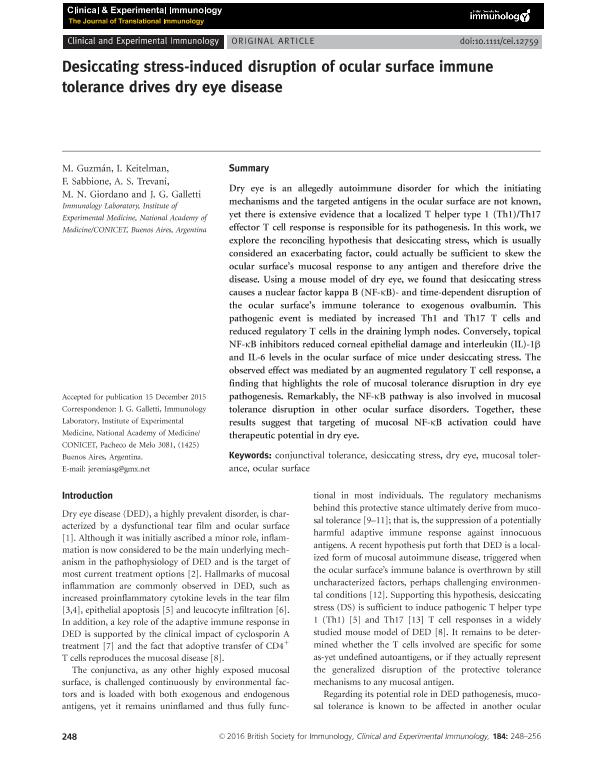Artículo
Desiccating stress-induced disruption of ocular surface immune tolerance drives dry eye disease
Guzman, Mauricio ; Keitelman, Irene Angélica
; Keitelman, Irene Angélica ; Sabbione, Florencia
; Sabbione, Florencia ; Trevani, Analía Silvina
; Trevani, Analía Silvina ; Giordano, Mirta Nilda
; Giordano, Mirta Nilda ; Galletti, Jeremías Gastón
; Galletti, Jeremías Gastón
 ; Keitelman, Irene Angélica
; Keitelman, Irene Angélica ; Sabbione, Florencia
; Sabbione, Florencia ; Trevani, Analía Silvina
; Trevani, Analía Silvina ; Giordano, Mirta Nilda
; Giordano, Mirta Nilda ; Galletti, Jeremías Gastón
; Galletti, Jeremías Gastón
Fecha de publicación:
2016
Editorial:
British Society for Immunology
Revista:
Clinical and Experimental Immunology
ISSN:
0009-9104
e-ISSN:
1365-2249
Idioma:
Inglés
Tipo de recurso:
Artículo publicado
Clasificación temática:
Resumen
Dry eye is an allegedly autoimmune disorder for which the initiatingmechanisms and the targeted antigens in the ocular surface are not known,yet there is extensive evidence that a localized T helper type 1 (Th1)/Th17effector T cell response is responsible for its pathogenesis. In this work, weexplore the reconciling hypothesis that desiccating stress, which is usuallyconsidered an exacerbating factor, could actually be sufficient to skew theocular surface?s mucosal response to any antigen and therefore drive thedisease. Using a mouse model of dry eye, we found that desiccating stresscauses a nuclear factor kappa B (NF-jB)- and time-dependent disruption ofthe ocular surface?s immune tolerance to exogenous ovalbumin. Thispathogenic event is mediated by increased Th1 and Th17 T cells andreduced regulatory T cells in the draining lymph nodes. Conversely, topicalNF-jB inhibitors reduced corneal epithelial damage and interleukin (IL)-1band IL-6 levels in the ocular surface of mice under desiccating stress. Theobserved effect was mediated by an augmented regulatory T cell response, afinding that highlights the role of mucosal tolerance disruption in dry eyepathogenesis. Remarkably, the NF-jB pathway is also involved in mucosaltolerance disruption in other ocular surface disorders. Together, theseresults suggest that targeting of mucosal NF-jB activation could havetherapeutic potential in dry eye.
Archivos asociados
Licencia
Identificadores
Colecciones
Articulos(IMEX)
Articulos de INST.DE MEDICINA EXPERIMENTAL
Articulos de INST.DE MEDICINA EXPERIMENTAL
Citación
Guzman, Mauricio; Keitelman, Irene Angélica; Sabbione, Florencia; Trevani, Analía Silvina; Giordano, Mirta Nilda; et al.; Desiccating stress-induced disruption of ocular surface immune tolerance drives dry eye disease; British Society for Immunology; Clinical and Experimental Immunology; 2016
Compartir
Altmétricas



